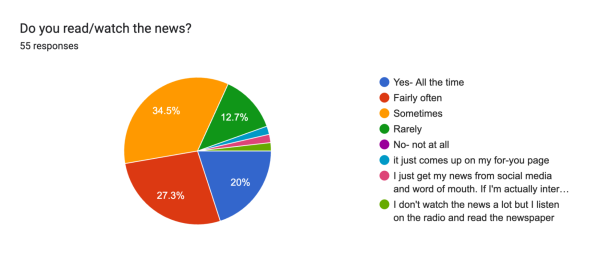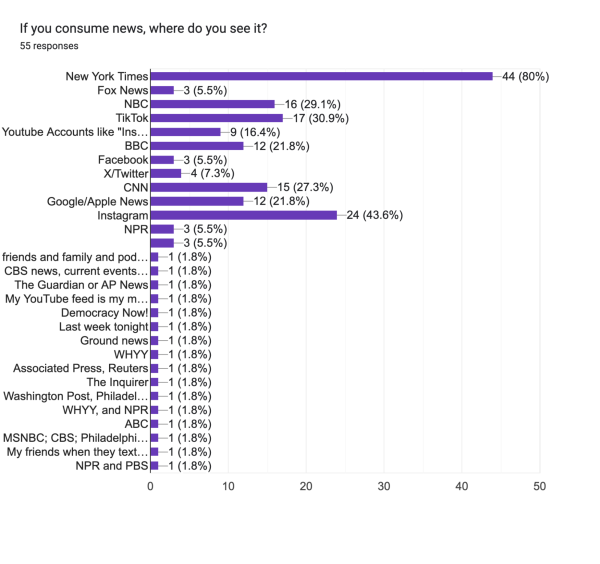
Kylie Firmin '26
Due to the rise in popularity of digital media, the use of physical newspapers has declined.
Through a time of constant change, news sources provide information, some of which hold varying perspectives, and at times, biases.
This past week, students of all high school grades and teachers were surveyed on where they get their news. The Abington Friends community, similarly to the United States population, holds a variety of different peoples and perspectives, meaning that the sources students and teachers receive their news from vary heavily.
Students and faculty were first asked how often they consume news. 34.5% of students and faculty stated that they consume news “sometimes.” That was closely followed by 27.3% of people who said they consume news “often,” 20.0% of people who read/watch the news “all the time,” and 12.7% of responders who consume the news “rarely.”

Responders were then surveyed on where they read/watch news. Results were as follows:

The survey data concluded that the New York Times (80%), Instagram (43.6%), TikTok (30.9%), NBC (29.1%) and CNN (27.3%) made up the top five most actively used sites.
Some responders added that other systems of news included Spotify podcasts, CBS, NPR, the Wall Street Journal, Heather Cox Richardson’s blog, and the Inquirer.
The variety of news sources, social media included, clearly reflects just how diverse systems of news look like in modern day.
One clear trend, both in the survey’s data and nationally analyzed, is the rise in Americans consuming their news through social media. Though the New York Times was by far the most used source of responders, at least 4/10 responders got news from Instagram and/or TikTok.
Pew Research Center similarly reported in a recent study that “About 4 in 10 young adults in the U.S. now regularly get news on TikTok.”
The study also found that “around half of TikTok users (52%) now say they regularly get news there.”
Last year, The New York Times wrote an article titled “Teenagers Tell Us About Their Relationship With News.”
The article quoted students of varying grade levels, and political views, but one trend between responses stood out, teenagers are consistently getting their news off of social media. The article also featured four students from AFS’s thoughts: two alumni, Neveah Brown ‘25 and Timmy Ma ‘25, and two current upper school students, Grace Moore ‘26 and Bella DiToro ’27.
In the article, DiToro said, “However, navigating true and false information on social media can be extremely difficult. Media literacy and lateral reading is becoming increasingly necessary for anyone navigating the online news space.”
DiToro brings up a crucial point, highlighting that a range in news media can be very crucial, and in this time, as The New York Times says, “the vast majority of teenagers said they get their news primarily from social media.”
This factor is not necessarily a bad thing, as it turns out that many large news sites, including the New York Times, run Instagram accounts, and provide digital media in a new form through sites like Instagram and TikTok.
A geography teacher was interviewed by The Guardian where they said, “We have accepted that reading newspapers comes with political and social angles, but social media exacerbates this further by denying broad coverage.”
Ollie Davies, the teacher interviewed, brings up a good point: are social media algorithms reliable? Do they provide accurate information?
One thing is clear: both students and teachers in and out of the AFS community are relying on social media to receive news.